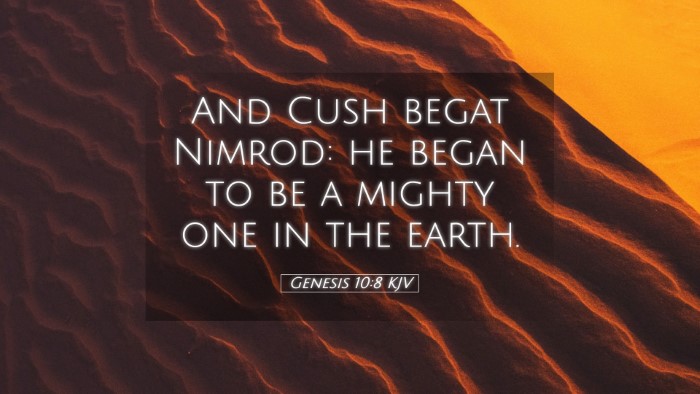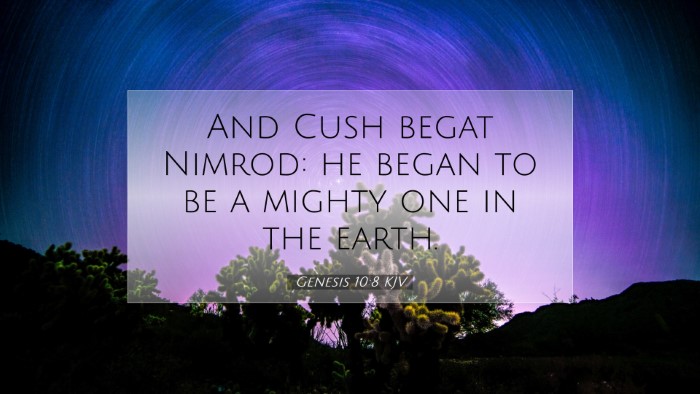Commentary on Genesis 10:8
Verse: "And Cush begat Nimrod: he began to be a mighty one in the earth."
Introduction
This verse introduces Nimrod, who is presented as a significant figure in the genealogies of Genesis. His portrayal is often debated among theologians and scholars. By surveying commentary from public domain sources like Matthew Henry, Albert Barnes, and Adam Clarke, we can uncover deeper insights into the implications of Nimrod's emergence and his broader relationships within the biblical narrative.
Historical Context
Matthew Henry notes that the genealogies in this chapter hold more than just a historical listing; they reveal the spread of nations and the character of their foundational leaders. Cush, mentioned here as Nimrod's father, is often associated with regions in Africa, highlighting the early dispersion of peoples following the Flood.
Nimrod's Legacy
Albert Barnes elaborates on the characterization of Nimrod as "a mighty one." This phrase indicates not just physical prowess but also implies a ruler-like quality, suggesting military strength and influence over others. Barnes refers to Nimrod as a symbol of rebellion against divine order, attributing to him the foundations of cities and realms that would stand in distinction to God's covenant with humanity.
The Definition of "Mighty One"
Adam Clarke explores the original Hebrew term used for "mighty." This exerted strength or power could suggest not merely an ability in warfare or hunting, but also a man of renown who influenced others and was perhaps a persecutor of the righteous. Clarke underscores that Nimrod's significance in Scripture is not only historical but also typological.
Nimrod as a Hunter
Matthew Henry further contextualizes Nimrod's prowess as a "mighty hunter" (noted in subsequent verses). Henry posits that the hunting Nimrod symbolizes mankind's dominion over the earth—a divine command (Genesis 1:28)—while simultaneously inviting scrutiny of how that dominion is exercised. Nimrod’s hunting, thus, becomes symbolic of greater pursuits—political, social, and military dominance.
Nimrod and the Tower of Babel
The later chapters of Genesis reveal that Nimrod is often associated with the Tower of Babel (Genesis 11). Albert Barnes observes that Nimrod’s act of founding cities may very well be linked with the rebellion against God’s ordinance to spread out and fill the earth. Nimrod epitomizes the unity of man in defiance of God—an epitome of pride that seeks to make a name for oneself (Genesis 11:4).
Theological Implications
This narrative has profound theological implications. Adam Clarke indicates that Nimrod represents the tendency of humanity to seek power apart from divine authorization. This quest for autonomy is a reiterative theme in the early chapters of Genesis, marking the human condition post-Fall. Nimrod could be viewed as both a symbol of success and a warning against tyranny in leadership—a duality that challenges theologians to engage with the narrative critically.
Cultural Reflections
Moreover, Matthew Henry reflects on the cultural implications of Nimrod's legacy; his name has become synonymous with power and rebellion in literature and folklore. The cultures that emerged in the post-Flood period reflect diverse responses to humanity’s ongoing struggle with sin and the redemptive promise of God.
Conclusion
Colloquially speaking, Nimrod stands as a mirror reflecting the complexities of human ambition and its outcomes. His mention in Genesis 10:8 invites pastors, students, and theologians to contemplate not only the historical narrative but also the ongoing implications of human agency in shaping cultures and societies in opposition to God's will.
Reflection Questions
- What lessons can contemporary leaders learn from the narrative of Nimrod?
- How does the theme of rebellion against God manifest in modern society?
- In what ways can the church today respond to the cultural symbols of power like that of Nimrod?


